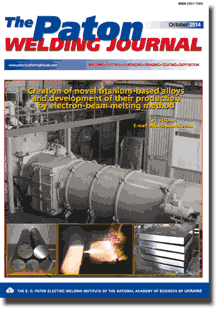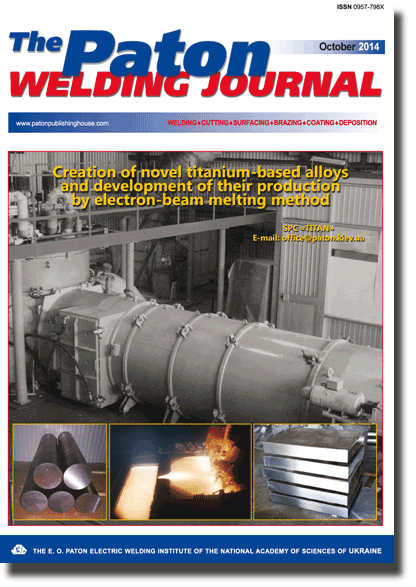| 2014 №10 (02) |
DOI of Article 10.15407/tpwj2014.10.03 |
2014 №10 (04) |

The Paton Welding Journal, 2014, #10, 15-21 pages
MICROSTRUCTURE OF BRAZED JOINTS OF NICKEL ALUMINIDE
S.V. MAKSYMOVA, V.F. KHORUNOV, V.V. MYASOED, V.V. VORONOV and P.V. KOVALCHUK
E.O. Paton Electric Welding Institute, NASU. 11 Bozhenko Str., 03680, Kiev, Ukraine. E-mail: office@paton.kiev.uaAbstract
Intermetallic alloys on the base of Ni3Al and NiAl phases belong to the new class of challenging casting structural materials. Application of Ni3Al-based materials allows increasing the service life of parts by 3-4 times, working temperatures of turbine inlet gas by 50-100 °C, reducing the mass of turbines and, as a consequence, increasing their specific thrust and efficiency. The wide application of alloys on Ni3Al base in industry requires the development of technological processes of producing permanent joints, including method of brazing, as the alloys, containing a high percent of γ’-phase, are referred to the class of hard-to-weld ones due to possible crack formation. At present, the nickel brazing filler alloys (BFA), containing silicon and boron as depressants, are used for brazing high-temperature high-alloy nickel alloys, thus leading to formation of brittle phases (silicides, borides) in joints, having a negative influence on fatigue life. Their elimination is connected with long-time conditions of heat treatment or almost impossible. The present work shows the possibility of application of eutectic BFA on nickel base, not containing boron and silicon. The results of metallographic examinations and X-ray spectral microanalysis of brazed joints of intermetallic alloys on the base of γ’-phase (Ni3Al) are given. Shown are the morphological peculiarities of structure formation of brazed joints, produced by high-temperature vacuum brazing and BFA on base of Ni-Cr-Zr and Ni-Co-Cr-W-Mo-Al-Nb-B systems. 7 Ref., 3 Tables, 15 Figures.
Keywords: intermetallic alloys, nickel aluminides, vacuum brazing, brazing filler alloy, brazed seam, spreading tests, microstructure, X-ray spectral microanalysis
Received: 12.03.14
Published: 28.10.14
References
1. Grinberg, B.A., Ivanov, M.A. (2002) Ni3Al intermetallics: Microstructure, deformation behavior. Ekaterinburg.
2. Povarova, K.B., Kazanskaya, N.K., Buntushkin, V.P. et al. (2003) Thermostability of structure of alloy based on Ni3Al and its application in blades of small-sized gas turbine engines. Metally, 3, 95-100.
3. Buntushkin, V.P., Kablov, E.N., Bazyleva, O.A. et al. (1999) Alloys based on nickel aluminides. MiTOM, 1, 32-34.
https://doi.org/10.1007/bf02466270
4. Buntushkin, V.P., Bronfin, M.B., Bazyleva, O.A. et al. (2004) Influence of alloying and structure of castings on heat resistance of Ni3Al intermetallics at high temperature. Metally, 2, 107-110.
5. Kablov, E.N., Buntushkin, V.P., Povarova, K.B. et al. (1999) Low alloy light heat-resistant high-temperature materials based on Ni3Al intermetallics. Ibid., 1, 58-65.
6. Khorunov, V.F., Perevezentsev, B.N., Ubirajlo, O.G. (2013) Examination of structure and chemical heterogeneity of joints of intermetallic Ni3Al alloy. In: Proc. of Int. Sci.-Techn. Conf. on Brazing, 255-264. Toliatti: TGU.
7. Khorunov, V.F., Maksymova, S.V. (2013) Prospective systems of filler metals for brazing of heat-resistant alloys based on nickel and titanium. Physical-technical problems of modern materials science, Vol.1, 105-134. Kiev: Akademperiodika.
Suggested Citation
S.V. Maksymova, V.F. Khorunov, V.V. Myasoed, V.V. Voronov and P.V. Kovalchuk (2014) Microstructure of brazed joints of nickel aluminide. The Paton Welding J., 10, 15-21.The cost of subscription/purchase order journals or individual articles
| Journal/Currency | Annual Set | 1 issue printed |
1 issue |
one article |
| TPWJ/USD | 384 $ | 32 $ | 26 $ | 13 $ |
| TPWJ/EUR | 348 € | 29 € | 24 € | 12 € |
| TPWJ/UAH | 7200 UAH | 600 UAH | 600 UAH | 280 UAH |
| AS/UAH | 1800 UAH | 300 UAH | 300 UAH | 150 UAH |
| AS/USD | 192 $ | 32 $ | 26 $ | 13 $ |
| AS/EUR | 180 € | 30 € | 25 € | 12 € |
| SEM/UAH | 1200 UAH | 300 UAH | 300 UAH | 150 UAH |
| SEM/USD | 128 $ | 32 $ | 26 $ | 13 $ |
| SEM/EUR | 120 € | 30 € | 25 € | 12 € |
| TDNK/UAH | 1200 UAH | 300 UAH | 300 UAH | 150 UAH |
| TDNK/USD | 128 $ | 32 $ | 26 $ | 13 $ |
| TDNK/EUR | 120 € | 30 € | 25 € | 15 € |
AS = «Automatic Welding» - 6 issues per year;
TPWJ = «PATON WELDING JOURNAL» - 12 issues per year;
SEM = «Electrometallurgy Today» - 4 issues per year;
TDNK = «Technical Diagnostics and Non-Destructive Testing» - 4 issues per year.


